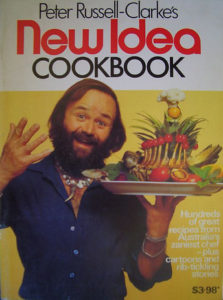When your child asks for sushi in their lunchbox instead of a white bread vegemite sandwich, you know times have changed.
A stroll to your local shopping strip, or a scroll down your preferred food delivery app, reveals a lot about the culinary tastes and trends of our nation. Fish and chips, charcoal chicken, burger and a beer – once synonymous with Aussie culture, no longer dominate the restaurant and take-away market. They have been superseded by souvlakis, pizzas, and sushi; and more recently by curries, banh mi, and of course, the burrito (extra sour cream, extra guac – thanks). According to the data, Australians’ taste in food has evolved beyond meat pies to something far more representative of our status as a prosperous, food-loving multicultural nation. Market research analysts NPD declared in 2018 that ethnic fast food is the most popular cuisine among Australian millennials. It begs the question:
“In 2019, what is Australian food?”
 You may as well ask “What does an Australian look like?” There’s no straightforward answer to either. Our palate is as diverse as the attendants at an Australian citizenship ceremony, or an AFL match (sorry, Rugby League if you’re from up north). As the song goes: “We are one, but we are many, and from all the lands on earth we come.” Since colonial times our interest in food has been largely shaped by global trends and waves of migration. An Australian summer staple, the pavlova was named after a visiting Russian dancer in the 1920s (apologies New Zealand, we know you claim its origin, but we’ll still claim it for dessert). Australian pub classic the chicken parma was inspired by an Italian eggplant dish. The well-loved Dim Sim (or “dimmie” as it’s often nicknamed), was in fact an Australian creation by a Chinese restaurateur in Melbourne in the 1940s, and has since become as ubiquitous as Smiths Chips. The Chiko Roll was born from the mind of a Bendigo boilermaker and made its debut in Wagga Wagga, a far cry from the land of the spring roll. But surely, Australian food has to be more complex than a bit of meringue or a deep-fried dumpling?! What does seem to be clear, is that since Australia began welcoming migrants from all backgrounds – regardless of race or religion – so too, have Australians embraced ethnic cuisines, and adapted them in our own unique ways.
You may as well ask “What does an Australian look like?” There’s no straightforward answer to either. Our palate is as diverse as the attendants at an Australian citizenship ceremony, or an AFL match (sorry, Rugby League if you’re from up north). As the song goes: “We are one, but we are many, and from all the lands on earth we come.” Since colonial times our interest in food has been largely shaped by global trends and waves of migration. An Australian summer staple, the pavlova was named after a visiting Russian dancer in the 1920s (apologies New Zealand, we know you claim its origin, but we’ll still claim it for dessert). Australian pub classic the chicken parma was inspired by an Italian eggplant dish. The well-loved Dim Sim (or “dimmie” as it’s often nicknamed), was in fact an Australian creation by a Chinese restaurateur in Melbourne in the 1940s, and has since become as ubiquitous as Smiths Chips. The Chiko Roll was born from the mind of a Bendigo boilermaker and made its debut in Wagga Wagga, a far cry from the land of the spring roll. But surely, Australian food has to be more complex than a bit of meringue or a deep-fried dumpling?! What does seem to be clear, is that since Australia began welcoming migrants from all backgrounds – regardless of race or religion – so too, have Australians embraced ethnic cuisines, and adapted them in our own unique ways.
“I’ve always said that I think Australian food is defined by the many ethnic communities that have migrated to Australia and the way we have as a collective, embraced their cooking techniques, ingredients and style”
Australian chef Dan Hong
 This is evident not only in the changing face of the local takeaway, but in our rabid appetite for cooking shows with their casts of culturally diverse chefs and “reality” players. We can’t get enough of celebrity chefs – from Chinese-Australian Kylie Kwong to Greek-Australian George Calombaris, Malaysian-born Poh Ling Yeow to Vietnamese-Australian Luke Nguyen – and we are certainly happy to patronise their restaurants too. Calombaris, of Masterchef fame, is now the owner of 20 restaurants offering his signature Greek cuisine. In fact, over the last four years, ethnic cuisines such as Mexican, Turkish, Indian, Greek and Italian, have been the fastest growing foodservice categories, with sales increasing by 63%. NPD attributes the rise in popularity to the active participation of millennials in food and restaurant culture. Which perhaps is also code for millennials being very comfortable in the multicultural landscape, perhaps even more so than previous generations.
This is evident not only in the changing face of the local takeaway, but in our rabid appetite for cooking shows with their casts of culturally diverse chefs and “reality” players. We can’t get enough of celebrity chefs – from Chinese-Australian Kylie Kwong to Greek-Australian George Calombaris, Malaysian-born Poh Ling Yeow to Vietnamese-Australian Luke Nguyen – and we are certainly happy to patronise their restaurants too. Calombaris, of Masterchef fame, is now the owner of 20 restaurants offering his signature Greek cuisine. In fact, over the last four years, ethnic cuisines such as Mexican, Turkish, Indian, Greek and Italian, have been the fastest growing foodservice categories, with sales increasing by 63%. NPD attributes the rise in popularity to the active participation of millennials in food and restaurant culture. Which perhaps is also code for millennials being very comfortable in the multicultural landscape, perhaps even more so than previous generations.
“Ethnic foods are fast becoming as Aussie as lamingtons and snags wrapped in sliced white bread.”
If we look at cosmopolitan Melbourne as a microcosm of multicultural Australia, you can see how different geographical areas are defined by their cultural specificity. Where the Victorian capital city used to have just Chinatown, there are now many distinct areas that are known for their migrant communities and the cuisines they are famous for. Locals and tourists alike are willing to travel far and wide in search of the next taste sensation. They’ll venture to Richmond just for a Vietnamese Pho, Footscray for Ethiopian injera, Oakleigh for a Greek Moussaka, Balaclava for a bagel, and Box Hill for Yum Cha. As we embrace these immigrant foods we are inadvertently reshaping our use of language, and evolving our national identity, creating pathways to not only appreciating those cultures, but understanding them. This results in immigrant languages and foods appearing in our day to day discourse and slang. Think how quickly Australians can turn a food phrase into a colloquialism: sanger, barbie, smashed avo, barra, snag. And think again about more recent incarnations of popular items on menus: sliders (mini burgers), bowls (rice, noodles), and wraps of any and every kind (falafel, burrito, souvlaki, – wrap it in gluten and we’ll eat it). No need to take an expensive trip to Southeast Asia. Restaurants flagrantly use the terms “hawker food” or “street food” to intimate the authenticity of their offerings.
“Food is the ultimate tool in fostering conversation and understanding between cultures.”
If anything, Australians’ relationship with food signals a shift in attitudes towards diverse cultures, races and religions. Food encourages conversation and understanding. Nick Temple, from Indigenous restaurant Charcoal Lane in Melbourne says, “People talk about Australia not having a cuisine… But when you’re in a space where you don’t recognise half of the ingredients on your plate, you’re not scared to ask questions. And that opens it up to more questions. It makes people recognise how much they don’t know about the country they live in.”What and how we eat changes the way we think about food, how we speak about food, and ultimately how we speak to each other. The feel-good takeaway (excuse the pun) from all this? Our rapid embrace of immigrant foods over the last ten years reflects our country’s capacity for tolerance and integration of an increasingly broad multicultural landscape.
“What’s next on the menu?”
We could hypothesise about the next food trend till the cows (or vegan friendly beef substitutes) come home. But there is no doubt that ethnic foods, just like ethnic culture is now intertwined with our personal identity. And more than ever, it is reflecting the core idea of Australia as a nation of battlers, each of us seeking a chance to flourish and succeed in a sometimes harsh and unforgiving physical and political climate. So, with the latest waves of new migrants coming from countries like South Sudan, Somalia,Iran, the Democratic Republic of Congo, Afghanistan, Eritrea, Ethiopia, Myanmar, Bhutan, Syria and Iraq, we can definitely expect new food trends. Before long you’ll probably be wrapping your mouth around some new taste sensations, and then, the Australianisation of those new tastes, with accompanying slang drifting into common parlance. So, pass the dead horse, and let’s go get some lunch.
“How have ethnic immigration trends impacted your business? Are you struggling to connect with culturally diverse communities?”
References
- https://qsrmedia.com.au/research/news/aussies-spending-more-ethnic-restaurants-study-says
- https://www.sbs.com.au/food/article/2017/11/12/are-we-any-closer-knowing-what-australian-f ood
- https://mattersjournal.com/stories/swallowingourhistory
- https://www.theguardian.com/australia-news/2018/apr/05/south-sudan-somalia-and-iran-excluded-from-one-of-australias-refugee-programs



